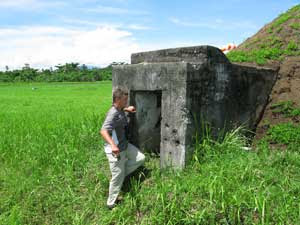

Lake Toba (Indonesian: Danau Toba) is a lake and supervolcano, 100 kilometres long and 30 kilometres wide, and 505 metres (1,666 ft) at its deepest point. Located in the middle of the northern part of the Indonesian island of Sumatra with a surface elevation of about 900 m (3,000 ft), the lake stretches from [show location on an interactive map] 2°53′N 98°31′E / 2.88°N 98.52°E / 2.88; 98.52 to [show location on an interactive map] 2°21′N 99°06′E / 2.35°N 99.1°E / 2.35; 99.1. It is the largest volcanic lake in the world. In addition, it is the site of the 75,000-year-old supervolcanic eruption, the largest in the last 25 million years; where it staged a massive climate-changing event that scientists believe might have wiped out much of humanity. The massive eruption is believed to have a VEI intensity of 8.
The Toba caldera complex in Northern Sumatra, Indonesia consists of four overlapping volcanic craters that adjoin the Sumatran "volcanic front". The youngest and fourth caldera is the world’s largest Quarternary caldera (100 by 30 kilometres) and intercepts the three older calderas. An estimate of 2500-3000 cubic kilometres of dense-rock equivalent pyroclastic material, nicknamed the Youngest Toba tuff, was blasted from the youngest caldera during one of the largest single eruptions in geologic history. Following the "Youngest Toba tuff eruption", a typical resurgent dome formed within the new caldera, joining two half-domes separated by a longitudinal graben.
There are at least four cones, four stratovolcanoes and three craters visible in the lake.
Lake Toba offers a nurturing environment for fish such as the tilapia mossambica, aplocheilus pachax, lebistes reticulatus, osphronemus goramy, trichogaster trichopterus, channa striata, chana gachua, clarias batrachus, clarias nieuhofi, clarias. sp., nemachilus fasciatus, cyprinus carpio, puntius javanicus, puntius binotatus, osteochilus nasselti, lissochilus sp., labeobarbus sora, and rasbora sp.
Many other types of plants and animals live within the boundaries of Lake Toba. Flora organisms include various types of phytoplankton, emerged macrophytes, floating macrophytes, and submerged macrophytes. Fauna include several variations of zooplankton and benthos
Local transportation around the lake takes the form of boats (cheaper, school boats with limited schedules and more expensive public boats that operate throughout the day).
Public Boats from Parapat and surrounding areas sail from either Ajibata or Tigaraja to Tuktuk or Tomok at Samosir Island. The fee is 7,000 IDR per trip. There is also bigger ship which transports Cars and Busses sailing between Tigaraja and Tomok.
Hire a motorcycle for a day or two and get out and about (Rp.70,000 per day inclusive of 4 litres of petrol). Take a map. There are no police checking licenses and there is not much traffic - just watch out for the big trucks, buses and diabolical bridges. A good journey to take on a motorcycle would be to travel North from Tuk Tuk around to the western shore, stopping at the tourist sites along the way such as the many and varied traditional houses and villages. The roads are very bad in the centre of the island (bumpy and washed out) and it takes half a day to cross this way (verse 1-2 hours by coast road which is more scenic anyway). You can expect to ride at least up to 100km in the day.
It may be obvious but just remember there are no taxis around Tuk Tuk. Sure you can walk the small part of the island in an hour or so but if you are heading out for the night plan ahead on how you will get back home. The locals are very friendly people. WONDERFUL PEOPLE who will go out of their way to help. However, some corners of the island are very quiet at night and you may find yourself on a long long walk.
Most of the cottages and guest houses at Tuk Tuk will rent you a very serviceable bicycle for a nominal fee, this is a very much preferred way to get around, but be very careful for the cars as nobody looks and there does not seem to be any right side of the road, even when its the left side.



















